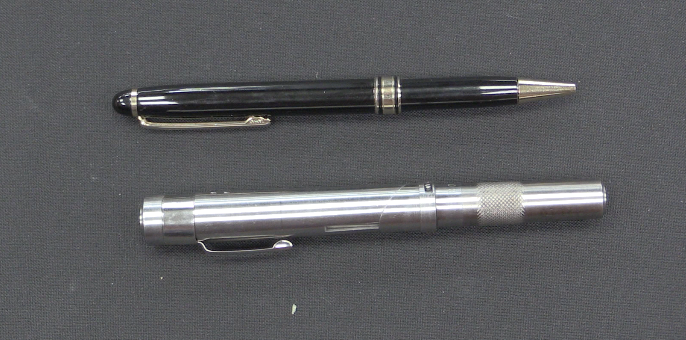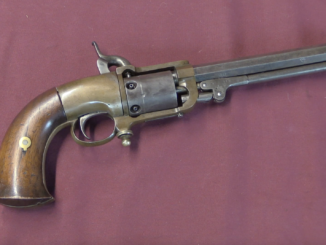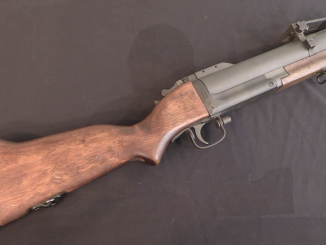JD Jones’ .950 JDJ cartridge is a generally described as the largest sporting rifle cartridge ever produced, producing more energy than even the 4-bore cartridges that match it in bore diameter. Only three of these rifles were made, and the original loading was a 2600 grain (168g) cast bullet moving at 2200 fps (670m/s), for a whopping 28,000 foot-pounds of muzzle energy (38kJ). There are some antitank rifles that produce more, but nothing comparable in both energy and bore diameter in the sporting realm.
The rifle, named “Fat Mac”, is built on a McMillan stock and action, and was originally produced on special order for a customer who wanted a really (really) big rifle that could use cast bullets. The cartridge cases were originally made from 20mm Vulcan cases trimmer down to a (mere) 70mm case length, with custom made lathe-turned cases replacing them when brass Vulcan cases became too difficult to source. The gun itself weighs a bit over 60 pounds, with nearly a third of that in the muzzle brake alone. This example is being sold with a whole bunch of ammunition components, which is a good thing since Jones/SSK stopped making the ammunition several years ago…




Yikes! Your big friend seems to want grizzly bear on the table tonight! And if I am not mistaken about terminal ballistic behavior, a random stone wall would offer little protection. How would a Panzer IV G fare if Fat Mac shot into the hull or turret at 2 meters from the flank in ambush?
“(…)Panzer IV G fare if Fat Mac shot into the hull or turret at 2 meters from the flank(…)”
I assume you mean 2600 grain (168g) cast bullet moving at 2200 fps (670m/s), if so continue reading, else stop.
Cast bullet determines technology but no material, assuming Plumbum-Stibium alloy is used it would give rather poor armour-piercing capability.
Artillery AP shells used during World War II tended to use high-hardness materials, for example WC (Tungsten Carbide).
Artillery – usually yes, antitank rifles – not necessarily(see kb ppanc wz. 35).
Okay, I suppose that my idea was a bit too idealistic for the attacker. Suppose the rifleman shot a Kfz. 61 engine from up front? Would the Fat Max’s round blow the engine and kill the driver?
Kind of a pity that Rock Island got this item. “JDJ” seems to fit better with James D Julia.
My retinas say NO.
Speaking of eyes, I like how it appears to be drilled and tapped for a scope base on the receiver, in the typical place.
Just so a scope can be positioned riiight in front of your eyeball.
Meh… Anzio Iron Works makes a magazine fed bolt action in 20mm – not as big diameter bullet, but vastly more powerful. Sure, it’s a destructive device, but what’s a meager tax stamp when you want the most powerful rifle in the world? Or if having the biggest bullet suits your fancy, the 2 bore double rifle featured in an earlier video fills the bill: wasn’t it 1.3″ (or so) in diameter?
“cartridge cases were originally made from 20mm Vulcan cases trimmer down to a (mere) 70mm case length, with custom made lathe-turned cases replacing them when brass Vulcan cases became too difficult to source”
This caused me to thinking about suitable cases source for such big-sized cartridge and beyond auto-cannon cases in military usage I see none.
Even 12 gauge in caliber is “mere” ·707″ https://sites.google.com/site/britmilammo/air-service-wwi-non-303-inch/-707-inch-12b
so no way to mate it with .950″ bullet.
Due to ammunition availability issues, 12 gauge/98 mm codenamed 12 gauge from hell: http://www.municion.org/12_70/12GaugeFromHell.htm
seems to better to anyone wanting to have BIG projectile going quite fast.
I presume weapon for it would accept also normal 12 gauge/70 mm ammunition
Or was it designed to be shot in standard .12 x70mm?
“Hunting rifle”
Is he hunting Cthulhu?
For Cthulhu, you need Miskatonic Gun Works hollow point round….”Sometines they charge when wounded”
https://www.pritzkermilitary.org/explore/museum/digital-collection/view/oclc/949446111
We’re can I get live ammo though? I’m willing to buy and shoot it but where can I get the ammo